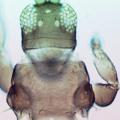Frankliniella minuta
Recognition data
Distinguishing features
Both sexes fully winged. Body, legs and antennae brown, antennal segment III sometimes paler; fore wing brown. Head wider than long; three pairs of ocellar setae present, pair III short, no longer than diameter of one ocellus, arising on anterior margins of ocellar triangle; postocular setae pair I not present, pair IV shorter than diameter of hind ocellus. Antennae 8-segmented; segments III–IV with sensorium forked, segment VIII longer than VII. Pronotum with anteromarginal and anteroangular setae scarcely longer than discal setae; 2 pairs of long posteroangular setae present; one pair of minor setae medially between posteromarginal submedian setae. Metanotum with 2 pairs of setae close to anterior margin, campaniform sensilla not present. Fore wing with 2 complete rows of veinal setae. Abdominal tergites V–VIII with paired ctenidia; ctenidia weakly developed on IV, on VIII anterolateral to spiracle; posteromarginal comb on VIII with long, slender microtrichia, the six median teeth usually converge at their apices. Sternites III–VII without discal setae.
Male smaller than female; tergite VIII with complete posteromarginal comb; sternites III–VII with transverse pore plate.
Related and similar species
The F. minuta group (Sakimura & O'Neill, 1979) comprises about 24 species, all of which have the major setae unusually small. These species are particularly associated with flowers of the Asteraceae, and are known mainly from South and Central America and western USA. Among the members of this group known from the USA, F. minuta is particularly similar to F. davidsoni.
Taxonomic data
Current valid name
Frankliniella minuta (Moulton)
Original name and synonyms
- Euthrips minutus Moulton, 1907: 56
- Euthrips minutus var. setosus Crawford DL, 1909: 105
- Frankliniella minuta f. luminosa Moulton, 1948: 60
Family placement
Thripidae, Thripinae
Biological data
Life history
Breeding in flowers
Host plants
Collected from many different Asteraceae. Adults have been recorded from a wide variety of other plants, including tree crops such as pear and plum but without records of breeding.
Tospoviruses vectored
None
Crop damage
None recorded.
Distribution data
Area of origin
Possibly Central America
Distribution
In western USA from Utah and Wyoming southward through California, to Mexico and Guatemala, Costa Rica, Panama, Colombia and Peru; also Hawaii.




